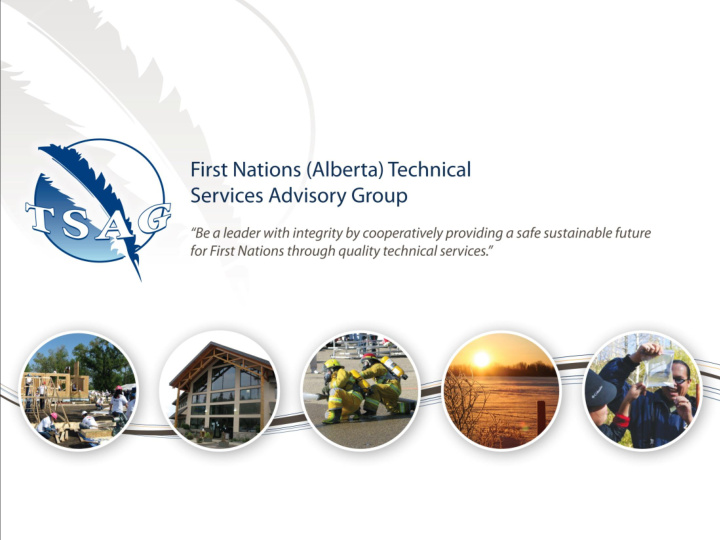



Source Water Protection Planning Rosey Radmanovich, M.Sc. Environmental Liaison First Nations Technical Services Advisory Group May 2017
TSAG – a quick overview • Non-profit corporation started in 1998 • Mandated by Chiefs of Alberta at Chiefs Summit V • Treaties 6, 7 and 8 in Alberta • Chiefs’ Steering Committee and BOD
Our Mandate • Be a leader with integrity by cooperatively providing a safe sustainable future for First Nations through quality technical services. o Circuit Rider Training Program o Housing o Fire Prevention o Asset Management o Information Technology o Environmental Management
Source Water Protection What? Why? How? Photo: R. Patrick Patrick 2014
What is Source Water Protection? • Source water = where drinking water comes from • Protection planning = have a plan to keep the water safe
Source Water Protection in Canada • Walkerton, ON. May 2000 – 7 deaths – 2300 illnesses • Walkerton Inquiry (Justice D. O’Connor, 2002) – 93 recommendations – First 13 mention source water protection! Patrick 2014
Multi-Barrier Approach 1. Source Protection 2. Water treatment -filtration -disinfection -UV 3. Distribution 4. Monitoring 5. Response Plan Patrick 2014 Image: CCME, 2002
Why Source Protection? • Public health protection • Encourages environmental stewardship • Reduces water treatment challenges • Reduces system operating costs
First Nation Source Water Protection Planning • Community-based plan to protect drinking water • Plan to make sure your community is safe
• AANDC funded the creation of an on- reserve source protection guide and template • Guide and template were piloted in Treaty 7, Alberta, with Siksika Nation in 2013 • Available on INAC’s website
TSAG’s Program • Facilitate the process of SWPP • INAC has committed funding to complete 10 plans in 2016/17 and 20 plans in 2017/18 • TSAG’s ultimate goal is to help develop a plan for every Alberta First Nation that wants one
Source Water Protection PLANNING
How to Develop a Source Water Protection Plan? 5 STAGE PROCESS 1. Form a working committee 2. Figure out specific concerns or threats to water in your area 3. Figure out what can be done to “fix” or minimize the concerns 4. Come up with a plan for accessing funding and establishing partnerships 5. Go back, review SWP Plan (stages 1 to 4)
Stage 1: Form a Working Committee • Key first step to ensure that the right people are at the table • This step should be used to inform the larger community about the project • Want to ensure representation of community values and concerns
Activity 1: Form a Working Committee • Who should be on the working committee? o Elder(s) o Youth o Community councillor(s) o Lands department o Environment department o Housing department o Agriculture department o Water treatment plant operator; water truck operator o Circuit rider o Other ?? Patrick 2014
Stage 2: Figure out the threats in your area • Decide on the area to be included in the plan • Record information about the system • Investigate existing land use practises and their impacts on water • Assess the risk of contamination from land use practises
Stage 2: Delineate Boundary of Your Source Water www.usepa Patrick 2014
Stage 2: Map Source Water Supply Patrick 2014 www.usepa
Stage 2: Investigate land use practises • Investigate current land uses • Evaluate the risk of land use Photo: G. Enns Patrick 2014
Stage 2: Source Water Assessment • Example: – Threat: Unlined dump – Potential contaminate: Pharmaceuticals, household hazardous waste – Threat: Uncapped wells – Potential contaminate: Coliform bacteria, dead animals
Stage 3: Management Actions • Determining what is and what can be done to mitigate impacts from land use practises
Stage 3: Management Actions • Unlined dump: – Test wells for leaching – Construction of a transfer station – Decommission dump
Stage 3: Management Actions • Uncapped wells: – Cap the wells – Home owner awareness Photo: R. Patrick
Stage 4: Planning Implementation • Prioritizing mitigation actions • Identifying funding sources • Setting timelines
Stage 5: Reviewing the SWP Plan • On a regular interval the steering committee will review: – Membership, – Water assessment, – Management actions, – Implementation (Steps 1-4) Patrick 2014
SWPP Benefits • Lists and ranks land use risks to source water – Allows prioritization of resources • Helps the community decide what steps should be taken and when – Long term plan that lays out a strategy for accessing funding
SWPP Benefits • Lists who can be partnered with to work on which challenges • Raises awareness about water within the community
SWPP Successes • Fosters relationship building • Bigstone Cree Nation working with the Municipality of Opportunity • Frog Lake First Nation is partnering with NGOs
SWPP Successes • Leverage additional dollars • Promotes environmental stewardship • Reduces water treatment plant challenges & costs
Take Home Message Today! • SWP is preventative, proactive action • SWP fosters relationship building • SWP enables leverage for additional dollars • Easier and cheaper to prevent water contamination than it is to clean-up contamination • SWP is all about public health protection! • SWP promotes environmental stewardship & education • SWP reduces water treatment plant challenges & costs “Planning for prevention is always better than reacting to a problem” Patrick 2014
“There is no greater medicine than water – it is foundational, our very beginnings, it reminds us where we came from, our first environment in the womb.” Elder, Chiefs of Ontario 2006 Questions? For more information: Rosey Radmanovich, MSc. Environmental Liaison Phone: 780-483-8601 Email: rradmanovich@tsag.net Patrick 2014
Recommend
More recommend